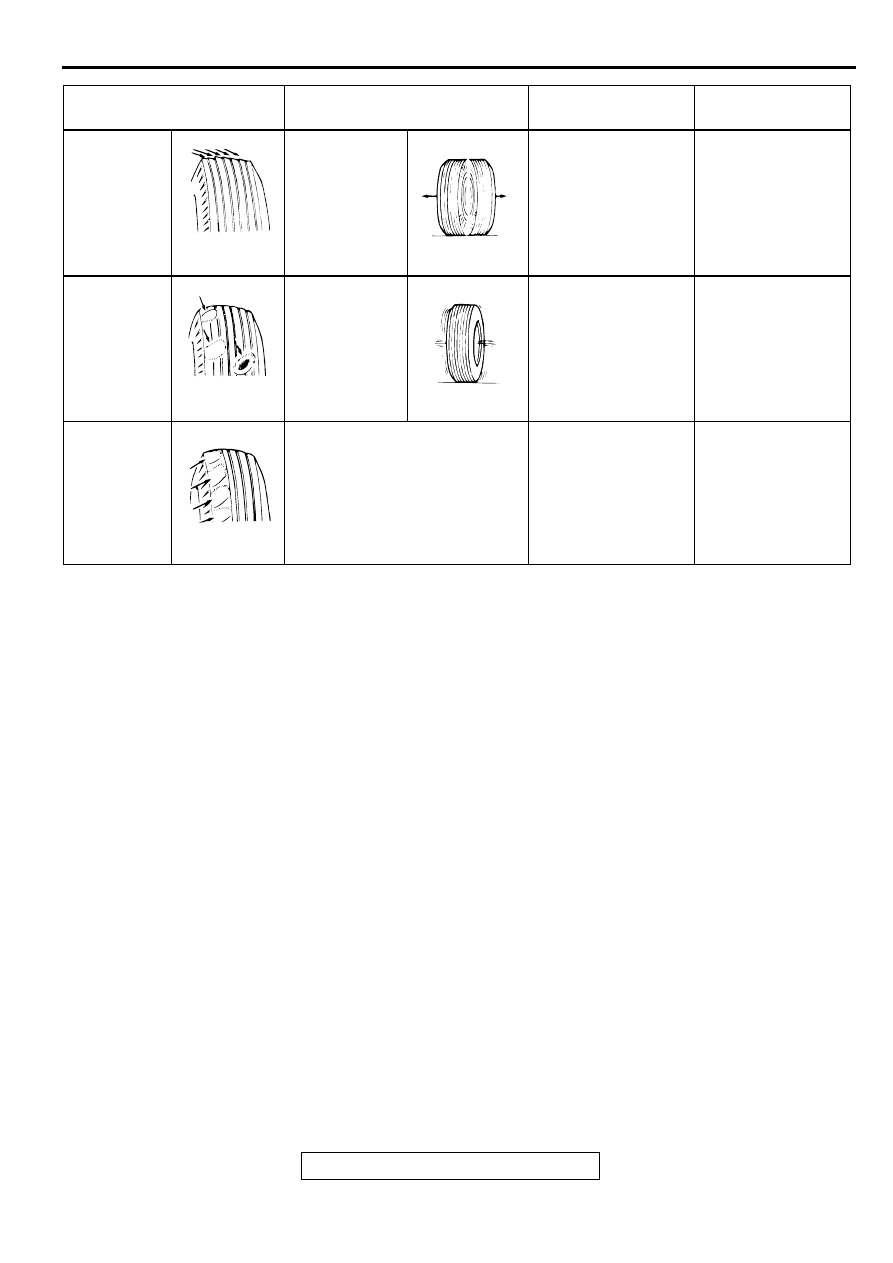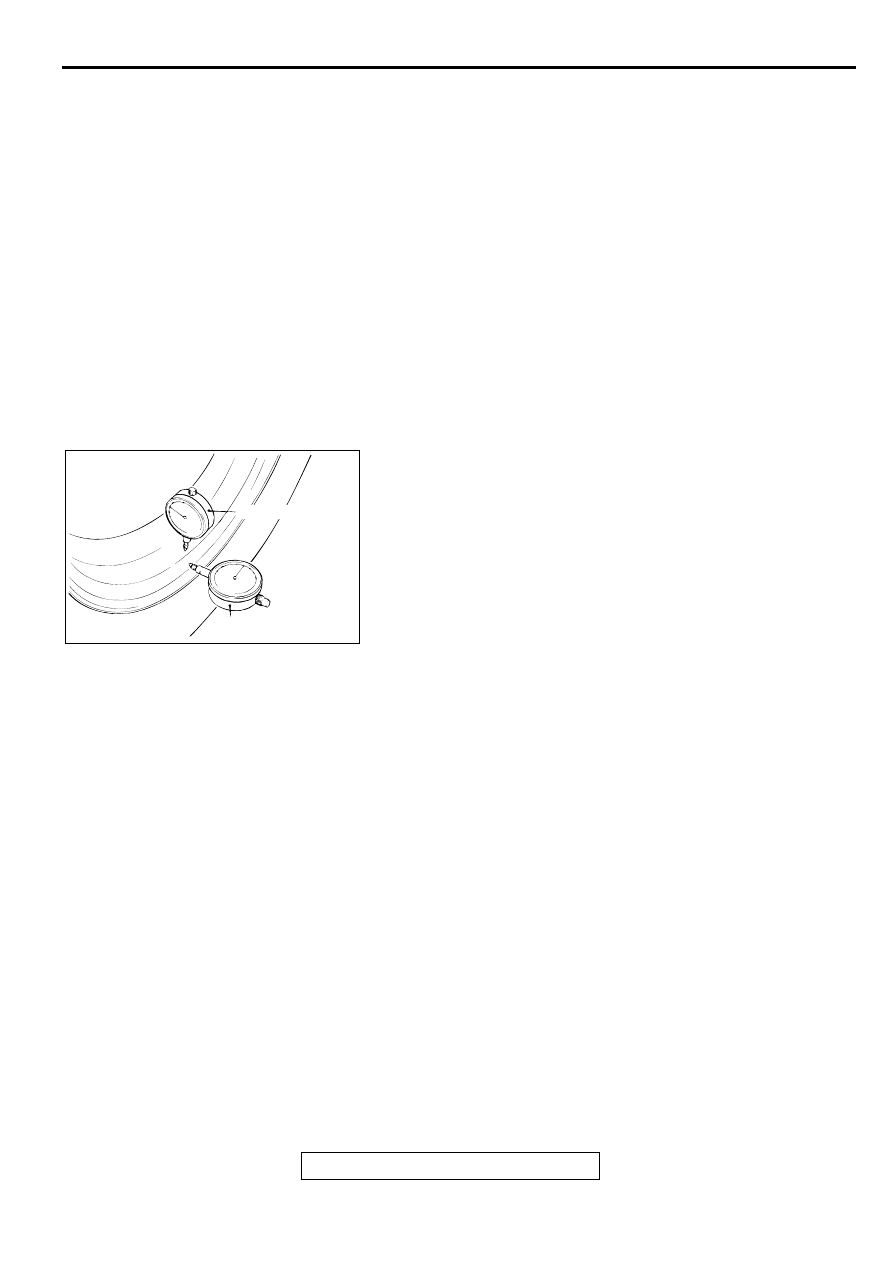Mitsubishi Eclipse / Eclipse Spyder (2000-2002). Service and repair manual — part 547

WHEEL AND TIRE DIAGNOSIS
TSB Revision
WHEEL AND TIRE
31-3
WHEEL BALANCE ACCURACY
M1311001700010
PURPOSE
This section contains tips and procedures for
achieving accurate wheel balance. Steering wheel
vibration and/or body shake can result if any of these
procedures are not carefully observed.
1. Wheels and tires must be properly mounted on a
balancer in order to achieve correct balance.
Centering the wheel on the shaft of the balancer is
essential for proper mounting.
2. Off-the-car wheel balancers must be calibrated
periodically to ensure good balancing results. An
inaccurately calibrated balancer could cause
unnecessary replacement of tires, shocks,
suspension components, or steering components.
Check your balancer's calibration approximately
every 100 balances. Your wheel balancer's
instruction manual should include calibration
procedures. If the calibration procedures specifically
for your balancer are missing, use the generic steps
in this section for zero calibration, static balance, and
dynamic balance checks. The wheel balancer
calibration checks are also described in the
flowchart. (Refer to
PROCEDURE <Balancing Tips>
1. Confirm that the balancer's cone and the wheel
mounting cone are undamaged and free of dirt
and rust.
2. On this vehicle, the wheel's center hole on the
hub side has a chamfered edge. Use a back-
mounting cone on your wheel balancer to center
the wheel on the balancer shaft.
3. Install a wheel mounting cone. The appropriate
size cone for this vehicle is 67.0 mm (2.64
inches).
4. Before balancing the wheel, remove any wheel
weights from both sides. Also check both sides for
any damage.
5. When installing wheel weights, hammer them at a
straight (not diagonal) angle.
Feathered
edge
Incorrect toe-in
Adjust the toe-in.
Bald spots
Unbalanced
wheel
Balance the wheels.
−
Scalloped
wear
Lack of rotation of tires or worn
or out-of-alignment suspension
Rotate the tires,
check the front
suspension
alignment.
Refer to GROUP
33A, On-vehicle
Service
−
Front
Wheel Alignment
Check and
Adjustment
.
SYMPTOM
PROBABLE CAUSE
REMEDY
REFERENCE
PAGE
ACX00930AB
ACX00931 AB
ACX00932AB
ACX00933 AB
ACX00934

WHEEL AND TIRE DIAGNOSIS
TSB Revision
WHEEL AND TIRE
31-4
<Confirming Proper Balance>
1. After balancing the wheel, loosen the wing nut
and turn the wheel 180 degree angle against the
balancer's hub. Then re-tighten the wing nut and
check the balance again. Repeat wheel balance if
necessary.
2. Turn the wheel again 180 degree angle against
the balancer's hub. If the wheel becomes out-of-
balance each time it is turned against the
balancer's hub, the wheel balancer may require
calibration.
<Wheel Balancer Calibration Checks>
1. Mount an undamaged original-equipment alloy
rim and tire assembly (wheel) onto your off-the-
car wheel balancer. Balance the wheel.
2. <<Zero Calibration Check>>
Loosen the balancer wing nut, rotate the wheel a
half-turn (180 degree angle), and retighten the
nut. Recheck the balance.
•
If the imbalance is 5 g (0.18 ounce) or less, the
zero calibration is OK. Rebalance the wheel, then
go to Step 4 to check static balance.
•
If the imbalance is more than 5 g (0.18 ounce), go
to Step 3.
3. Loosen the balancer wing nut, rotate the wheel 1/
4 turn (90 degree angle), and retighten the nut.
Recheck the wheel balance.
•
If the imbalance is 5 g (0.18 ounce) or less, the
wheel may not be centered on the balancer, or
the balancing cones, the cup, and/or wing nut are
damaged, dirty, or inappropriate for the wheel.
You may need to refer to the balancer
manufacturer's instructions to verify the correct
attachments. After making the necessary
corrections, recheck the wheel balance. If OK,
then go to Step 4.
•
If the imbalance is more than 5 g (0.18 ounce),
the balancer requires calibration. Contact the
balancer manufacturer for calibration by their
repair representative.
4. <<Static Balance Check>>
Attach a 5-g (0.18-ounce) weight to the outer rim.
Recheck the balancer. The balancer should
detect 5
±
2 g (0.18
±
0.06 ounce) of imbalance
170 to 190 degree angle away from the 5-g (0.18-
ounce) weight.
•
If the imbalance is within specification, the static
balance calibration is correct. Go to Step 5 to
check the dynamic balance.
•
If the imbalance is out of specification, the
balancer requires calibration. Contact the
balancer manufacturer for calibration by their
repair representative.
5. <<Dynamic Balance Check>>
Attach a 5-g (0.18-ounce) weight to the inner rim
at 180 degree angle opposite the 5-g (0.18-
ounce) weight that was added in Step 4. Recheck
the balance. The balancer should detect 5
±
2 g
(0.18
±
0.06 ounce) of imbalance 170 to 190
degree angle away from both the inner and outer
5-g (0.18-ounce) weights.
•
If the imbalance is within specification, the
dynamic balance calibration is correct. The
balancer calibration checks are complete.
•
If the imbalance is out of specification, the
balancer requires calibration. Contact the
balancer manufacturer for calibration by their
repair representative.
AC000041AB
HUB/SHAFT
ASSEMBLY
CLAMPING CUP
WING NUT
STANDARD PASSENGER
CAR WHEEL
WHEEL
MOUNTING
CONE
SPRING PLATE

WHEEL AND TIRE DIAGNOSIS
TSB Revision
WHEEL AND TIRE
31-5
WHEEL BALANCER CALIBRATION CHECKING FLOW CHART
AC000040
Balance wheel.
Rotate wheel 1/2 turn.
Imbalance = 5g (0.18oz) or less
Imbalance = more than 5g (0.18oz)
Rebalance wheel.
Rotate wheel 1/4 turn.
Imbalance = 5g (0.18oz) or less
Imbalance = more than 5g (0.18oz)
Verify wheel is properly centered.
Verify cones, cup, and wing nut are clean,
undamaged, and appropriate for wheel.
Make necessary corrections, then recheck
wheel balance.
Attach a 5-g (0.18-oz) weight to the outer rim.
Is the imbalance 5 ± 2g (0.18 ± 0.06oz) at 170
–
190
degree angle away from the 5-g (0.18-oz) weight?
YES
NO
Attach a 5-g (0.18-oz) weight to the inner rim at 180
degree angle opposite the weight on the outer rim.
Is the imbalance 5 ± 2g (0.18 ± 0.06oz) at 170
–
190
degree angle away from both 5-g (0.18-oz) weights?
YES
NO
Balancer does not require
calibration.
Balancer requires calibration.
Contact balancer manufacturer.
ZERO CALIBRATION
CHECK
STATIC BALANCE
CHECK
DYNAMIC BALANCE
CHECK
AB

ON-VEHICLE SERVICE
TSB Revision
WHEEL AND TIRE
31-6
O N -VEH IC LE SERVIC E
TIRE INFLATION PRESSURE CHECK
M1311000900022
NOTE: For information on tire inflation pressure, refer to the
label attached to the center pillar on the driver's side.
TIRE WEAR CHECK
M1311001000022
Measure the tread depth of the tires.
Minimum limit: 1.6 mm (0.06 inch)
If the remaining tread depth is less than the minimum limit,
replace the tire.
NOTE: When the tread depth of the tires is reduced to 1.6 mm
(0.06 inch) or less, wear indicators will appear.
WHEEL RUNOUT CHECK
M1311001100029
Jack up the vehicle so that the wheels are clear of the floor.
While slowly turning the wheel, measure wheel runout with a
dial indicator.
Limit:
Radial runout; 1.0 mm (0.04 inch) or less
Lateral runout; 1.0 mm (0.04 inch) or less
If wheel runout exceeds the limit, replace the wheel.
W H EEL A N D TIR E
INSTALLATION SERVICE POINT
M1311001300023
Tighten the wheel nuts to the specified torque.
Tightening torque: 98
±
10 N
⋅
m (73
±
7 ft-lb)
ACX00651AB
LATERAL
RADIAL

Нет комментариевНе стесняйтесь поделиться с нами вашим ценным мнением.
Текст